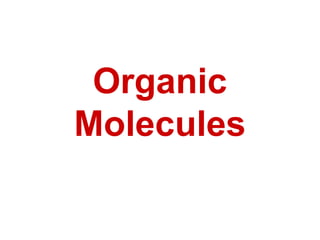
4 Groups Organic Compounds Living Things
- 2. 4 Groups of Organic Compounds Found in Living Things • “Organic” Compounds – Organic means “contains Carbon”
- 3. Carbon Molecules Carbon-based molecules have three basic structures Straight Chain Branched Chain Ring All structures based on carbon's ability to form four covalent bonds
- 4. • “Biomolecules” = large organic compounds – Built by bonding small molecules (monomers) together to form chains called “polymers” – Formed by a chemical reaction called “condensation”
- 5. Condensation H OH H20 H20 H20 “lysis” = split apart HOW TO BUILD A LARGER MOLECULE BY COMBINING SMALLER MOLECULES. HOW TO BREAK DOWN A LARGER MOLECULE INTO SMALLER MOLECULES. Hydrolysis
- 6. • ISOMER = Compounds with the same chemical formula, but different 3D structure Chemical formula C6H1206 = glucose C6H1206 = fructose 3D Structure O OH OH HO OH CH2OH O HOCH2 OH OH OH CH2OH
- 7. CARBOHYDRATES • Made up of C, H, & O • Main source of energy • Used for structural purposes in plants (cellulose)
- 8. CARBOHYDRATES • SIMPLEST = single sugar molecules = “monosaccharide” – Example: glucose, fructose glucose Monosaccharide fructose Monosaccharide Disaccharide sucrose H20 Think of each monosaccharide as a lego piece. A disaccharide is made up of two monosaccharides
- 9. CARBOHYDRATES • LARGEST = “polysaccharide” – Example: starch, fiber, cellulose, glycogen Polysaccharide A polysaccharide is made up of many monosaccharides.
- 10. Lipids • Aka “fats” • Made up of mostly C & H • Ex: fats, oils, waxes, steroids • Used to store energy (insulation, too) • Part of the cell membrane and waterproof covering • ALL are INSOLUBLE in water because they are NON POLAR
- 11. Most fats in our bodies and foods are in the form of 'triglyceride' molecules = one glycerol (or glycerin, a sugar alcohol) + three fatty acids attached Lipids
- 12. Lipids 2 Long chain of CH is called “fatty acid chain” Example: lard = maximum # of H+ atoms Example: olive oil = at least 1 C = C (carbon-carbon double bond) = more than one C = C (carbon-carbon double bond) Example: cooking oil
- 14. Nucleic Acids • They contain C, H, O, N, P • Nucleic Acids = polymers (made up of nucleotides) nucleotide nucleotide nucleotide N N N “Nucleic Acid” monomermonomer
- 15. Nucleic Acids • 3 parts of a nucleotide A) 5 carbon sugar (pentose) B) Phosphate group C) Nitrogenous base
- 16. Nucleic Acids • Store and transmit genetic info • 2 types – DNA sugar = deoxyribose – RNA sugar = ribose
- 17. Proteins • Contain C, H, O, N and some S • Basic building block = Amino acid (AA) • Peptide bonds hold molecules (AA) together Peptide bond
- 18. Proteins • 3 parts of an amino acid – amino acid (-NH2) – carboxyl group (-COOH) – R group (always different) • Hydrogen bonds fold amino acid into specific shapes for function
- 19. Protein • Each protein has a specific role – Control rate of reaction – Regulate cell processes – Form bones and muscles – Transport substances in/out of cell • Example: “enzymes” = “proteins” that change rate of reaction, increase pH and temperature